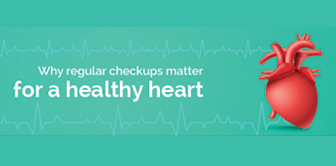Matters of the Heart: How to Keep your Heart Healthy
Sep 29, 2022

We are so involved in keeping up with the fast-paced world that we forget to take care of our health. An unhealthy lifestyle and stress level add to severe health issues. Today, India records more than 10.5 million deaths annually, with CVD (Cardiovascular Disease) leading to 20.3% of deaths in men and 16.9% of deaths in women.
You cannot immediately determine if you fall at high risk of developing
CVD, but you can certainly keep a note of signs and symptoms that might highlight underlying health issues.
Who are at a High Risk of CVD?
Individuals at risk of CVD may have elevated blood pressure, glucose and cholesterol levels and be overweight or suffer from obesity. Identifying people at the highest risk of CVDs and ensuring they receive appropriate therapy can save lives.
Healthy Changes for a Healthy Heart
CVDs (Cardiovascular disease) is the world’s leading killer, causing 1 in every 3 deaths. Heart attacks and strokes are usually caused by a combination of risk factors, such as tobacco use, unhealthy diet and obesity, physical inactivity and use of alcohol, hypertension, diabetes and high level of cholesterol.
Changes won’t happen overnight. However, you always have a choice to make gradual changes to your lifestyle for a healthier heart.
- Follow a Healthy Diet
A healthy diet that takes care of your heart includes a variety of foods such as fruits, vegetables, whole grains, legumes and nuts. Reduce your intake of salty meats and foods. Avoid consuming processed, canned, or fast food. Sweetened snacks, such as doughnuts and cookies, should be replaced with fresh fruit and vegetables. If thirsty, replace carbonated beverages and sweetened juices with water.
meats and foods. Avoid consuming processed, canned, or fast food. Sweetened snacks, such as doughnuts and cookies, should be replaced with fresh fruit and vegetables. If thirsty, replace carbonated beverages and sweetened juices with water.
- Manage Your Weight
Obesity never serves you well in the long run. High levels of fat and cholesterol are directly associated with an increased risk of developing cardiovascular disease. Reduce 500 kilocalories from your regular diet to achieve an average weight loss of at least 1kg (approx.) every week.
- Indulge in Physical Activities
Physical activity, even if only once a day, improves blood pressure, cholesterol, and other blood lipid levels and even aids in weight management. Inactive people should begin any physical activity of their choice and gradually increase its frequency and intensity. Adults should engage in at least 150 minutes per week of moderate physical exercise that induces a mild increase in heart rate.
- Stop Using Tobacco
Tobacco usage and passive smoking are both dangerous for your heart. Quitting smoking comes with immediate and long-term health benefits. Quitting smoking after a year reduces the risk of developing heart disease by around half that of a smoker.
- Avoid Alcohol
More than 200 illnesses and injury disorders, including cardiovascular diseases, have been linked to alcohol consumption. There is no safe level of alcohol consumption, so it is best to avoid it altogether to protect your heart.
- Check Blood Pressure and Sugar Levels Regularly
Getting your blood pressure and sugar levels checked by a heart expert is a vital step for a healthy heart. You may have high blood pressure but be unaware of it, which can be dangerous for your heart. If you have behavioural concerns (unhealthy eating, physical inactivity, use of tobacco and alcohol), speak with your health care provider so they can help you plan the lifestyle changes to get your heart health back on track. Set goals with your doctor if you have hypertension or diabetes, and take your medications regularly.
Get Regular Checkups
Changes you make to your lifestyle will definitely contribute to a healthy heart in the long run, but you also need expert guidance to keep you in the best of health. Regular checkups help in the accurate diagnosis and find the root cause of problems if any. Therefore, it is advisable to get regular checkups so that correct diagnosis, screening and testing help you lead a healthier and happier life.
Related Blog Post
Blog Categories
- Child Health
- Mens Health
- Women's Health
- Mental Health
- Health Myths & Facts
- Fitness
- Nutrition/Recipes
- Remedies
- Weight Management
- Stress Management
- Health Supplements
- Addiction Management
- Disease Management
- Allergy
- Anemia
- Arthritis
- Asthma
- Autoimmune Diseases
- Blood Pressure
- Cancer
- Deficiencies
- Dengue/Malaria/Chikungunya
- Diabetes
- Eye Problems
- Heart Diseases
- Hepatitis
- HIV/AIDS/STD
- Hormonal Imbalance
- Infection/Flu/Viral
- Kidney
- Liver
- Menstrual Problems
- Pregnancy
- Skin & Hair Problems
- Stomach Ailments
- Thyroid
- Others
- Health Checkups
- Diagnostics/Pathology
- Lifestyle & Wellness
- Covid
- Medical Tests
- Cholesterol
- Health Tips
- Parent Care/Old Age
- Lungs
- Food Intolerance








